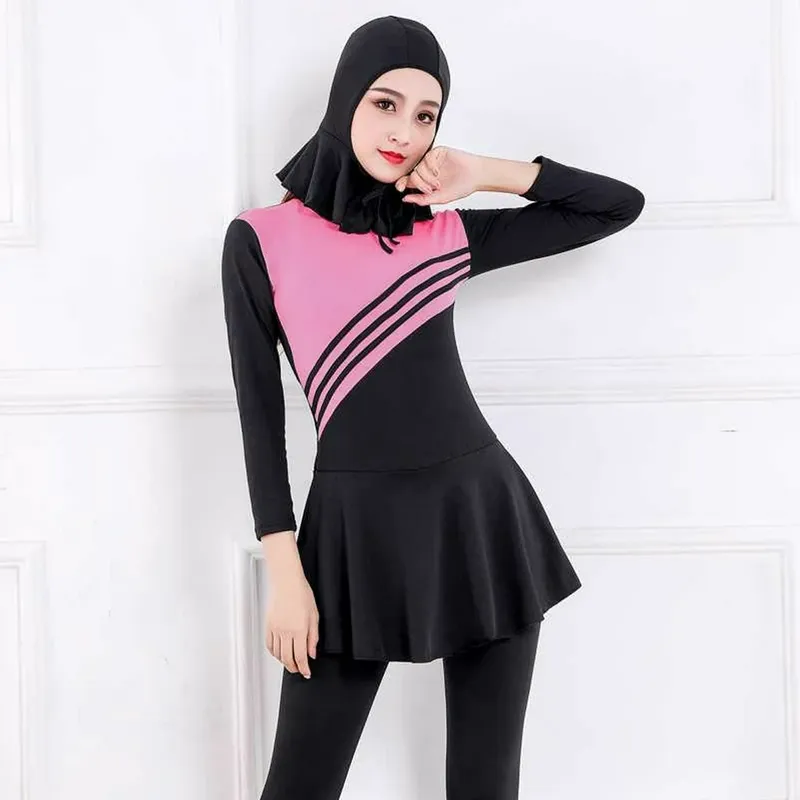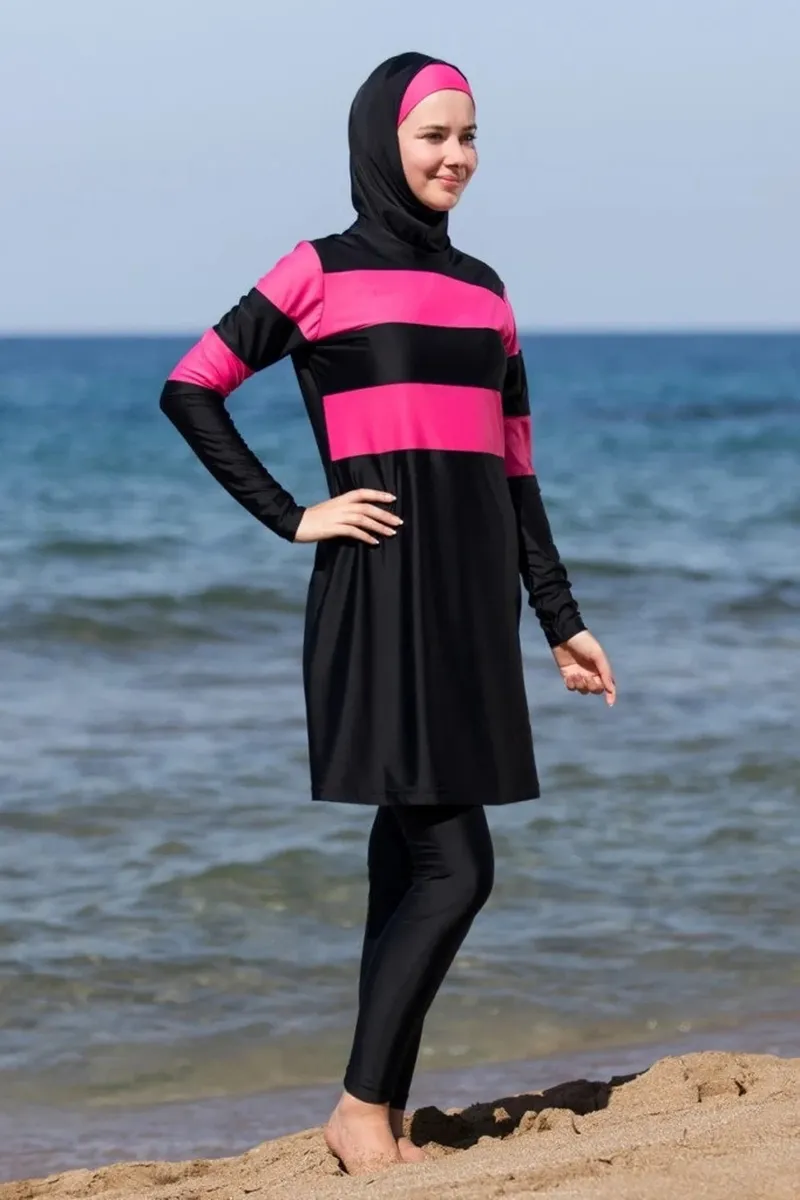Swimsuits come in various designs, styles, and materials to cater to different cultures, religious practices, and personal preferences. Among these, Muslim swimsuits stand out for their unique blend of modesty, functionality, and inclusivity. In this post, we’ll explore the key differences between Muslim swimsuits and other swimsuits, covering design, materials, cultural significance, and more.
Let’s dive in.

1. Design: Modesty Meets Functionality
Muslim Swimsuits
Muslim swimsuits, often referred to as "burkinis," are specifically designed to align with Islamic principles of modesty. These swimsuits typically feature:
- Full Coverage: Covers the entire body except for the face, hands, and feet.
- Loose Fit: Ensures the body shape is not accentuated.
- Two or Three-Piece Sets: Often include a tunic-style top, leggings, and a headscarf or hood.
Other Swimsuits
Mainstream swimsuits, on the other hand, prioritize aesthetics, performance, or minimalism. Common styles include:
- One-Piece Swimsuits: Cover the torso but leave the arms and legs exposed.
- Bikinis: Two-piece swimsuits that typically expose the midsection.
- Athletic Swimwear: Sleek designs focused on reducing drag in the water.
The stark contrast lies in coverage and purpose, with Muslim swimsuits centered on modesty and mainstream swimsuits often focusing on fashion or sport-specific needs.

2. Materials: Practicality and Comfort
Muslim Swimsuits
The materials used in Muslim swimwear are carefully chosen to provide:
- Quick-Drying Properties: Ensuring comfort after swimming.
- Stretchability: For ease of movement while maintaining coverage.
- UV Protection: Added layers often come with sun-blocking properties.
Common fabrics include polyester, nylon, and elastane blends, ensuring durability while adhering to modesty requirements.
Other Swimsuits
Mainstream swimsuits also use quick-drying and stretchable materials but often prioritize sleekness and hydrodynamics, particularly for athletic wear. Fabrics like Lycra or spandex are frequently used to achieve body-hugging fits.
The material selection for Muslim swimsuits must balance functionality with cultural needs, which sets them apart.
3. Cultural and Religious Significance
Muslim Swimsuits
The concept of modesty, or hijab, is central to Islamic teachings, influencing the design of Muslim swimwear. For many wearers, these swimsuits are a means of practicing their faith while enjoying recreational activities. The rise of modest fashion has further spotlighted the cultural importance of such attire.
Other Swimsuits
Mainstream swimwear lacks a universal cultural or religious connection, as its designs are typically guided by trends, athletic requirements, or aesthetic preferences. However, certain styles may be tied to specific cultural or historical origins, such as the bikini’s emergence in mid-20th-century fashion.
This distinction underscores the deeper purpose of Muslim swimsuits beyond simple functionality.

4. Inclusivity and Accessibility
Muslim Swimsuits
Muslim swimwear has become a symbol of inclusivity, providing an option for women who wish to participate in swimming or beach activities without compromising their beliefs. The availability of various sizes and designs caters to diverse body types and preferences within the Muslim community.
Other Swimsuits
While mainstream swimwear caters to a broad audience, it often lacks inclusive designs for those seeking modest options. This gap has spurred growth in the modest swimwear industry, with Muslim swimsuits now appealing to non-Muslim women seeking more coverage.
Inclusivity is a driving force behind the popularity of Muslim swimwear in global markets.
5. Controversies and Challenges
Muslim Swimsuits
Despite their rising acceptance, Muslim swimsuits have faced criticism and bans in certain countries, often stemming from political or cultural misunderstandings. Such challenges highlight the intersection of clothing with identity and personal freedom.
Other Swimsuits
Mainstream swimwear rarely faces similar scrutiny, reflecting its acceptance in most societies. However, issues such as body image and unrealistic beauty standards occasionally emerge within this market.
6. Market Growth and Trends
Muslim Swimsuits
The modest fashion industry, valued at billions of dollars, has propelled the growth of Muslim swimwear. Key trends include:
- Sustainable materials and ethical production.
- Customizable designs for individual preferences.
- Enhanced functionality, such as chlorine resistance and thermal insulation.
Other Swimsuits
Mainstream swimwear trends often mirror broader fashion movements, including bold patterns, eco-friendly materials, and performance-driven designs. Brands continually innovate to cater to a style-conscious audience.
The rise of Muslim swimwear reflects changing consumer values and increasing demand for inclusive options.

Conclusion
The differences between Muslim swimsuits and other swimsuits go beyond aesthetics, touching on cultural, religious, and practical dimensions. Muslim swimwear bridges the gap between faith and modern lifestyles, enabling individuals to enjoy aquatic activities while honoring their beliefs.
As the modest fashion industry continues to grow, Muslim swimsuits stand as a testament to the evolving definition of inclusivity in the global swimwear market. Whether for cultural identity or personal preference, these garments represent more than just clothing—they symbolize a harmonious blend of tradition and modernity.
If you're looking for a trusted partner to bring your swimwear designs to life, Tideline Swimwear is a leading manufacturer specializing in high-quality swimwear, including Muslim swimsuits. With years of expertise in crafting functional and stylish swimwear, Tideline Swimwear combines innovative designs, premium materials, and ethical manufacturing practices. Whether you're launching a modest swimwear brand or expanding your current collection, Tideline Swimwear can help you create pieces that resonate with modern consumers.
Explore their services and start your swimwear journey with Tideline Swimwear today.
